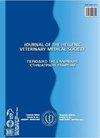使用Optiscan-TP和Optigrade-MCP设备对两种不同的方法进行比较评估,以预测希腊猪胴体的瘦肉百分比与欧洲参考方法的关系
IF 0.4
4区 农林科学
Q4 VETERINARY SCIENCES
引用次数: 0
摘要
瘦肉率(LMP)是评估猪肉胴体质量、确定胴体分类和价格的关键指标。这一框架为农民提供了实现所需感官特征的激励;因此LMP必须通过各种测量仪器进行客观的在线测量。这项工作的目的是与欧洲参考方法相比,评估两种不同的方法来预测希腊猪胴体的瘦肉百分比。因此,使用2个预测装置(Optiscan TP和Optigrade MCP)测量相同的130头猪胴体(65头雄性和65头雌性),随后根据欧洲参考方法进行评估。使用普通最小二乘法(OLS)构建了对应于每个设备的公式,并排除了相同的异常值。Optiscan TP和Optigrade MCP的所有130头胴体的计算RMSEP分别为2.46518和2.48489。可以得出结论,这两种方法完全符合欧盟立法(委员会条例(EC)1249/2008,欧盟,2008),无论测量点和技术不同,获得的结果都是相似的。本文章由计算机程序翻译,如有差异,请以英文原文为准。
A comparative assessment of two different methods, using devices Optiscan-TP and Optigrade-MCP, for predicting the lean meat percentage of pig carcasses in Greece in relation to the European reference method
Lean Meat Percentage (LMP) is a key index for assessing pork carcass quality as well as determining carcass classification and price. This framework offers to farmers the incentive to achieve the desired organoleptic features; therefore LMP must be measured objectively online, by means of various measuring instruments. The aim of this work was to assess two different methods for predicting the lean meat percentage of pig carcasses in Greece in comparison to the European reference method. For this reason, the same 130 pig carcasses (65 males and 65 females) were measured using 2 prediction devices (Optiscan-TP and Optigrade-MCP) and subsequently were assessed according to European reference method. A formula corresponding to each device was constructed using the ordinary least squares (OLS)method and excluding the same outliers. Calculated RMSEP for all 130 carcasses was 2.46518 for Optiscan-TP and 2.48489 for Optigrade-MCP. It can be concluded that both methods perform entirely according to EU legislation (Commission Regulation (EC) 1249/2008, European Union, 2008), and results obtained are similar regardless of different measurement points and technologies.
求助全文
通过发布文献求助,成功后即可免费获取论文全文。
去求助
来源期刊

Journal of the Hellenic Veterinary Medical Society
VETERINARY SCIENCES-
CiteScore
0.60
自引率
0.00%
发文量
83
审稿时长
>12 weeks
期刊介绍:
The Journal of the Hellenic Veterinary Medical Society (J Hellenic Vet Med Soc) is a quarterly peer-reviewed journal that publishes articles in all aspects of veterinary science and related disciplines. It is published by the Hellenic Veterinary Medical Society and is indexed in the Web of Science and in Scopus.
There are no publication fees in the journal. Authors considering submitting manuscripts for evaluation and publication are requested to read carefully the instructions for authors and fully comply with them.
Non-complying manuscripts may be returned to the corresponding author for formatting.
 求助内容:
求助内容: 应助结果提醒方式:
应助结果提醒方式:


